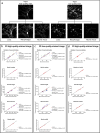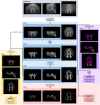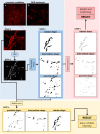Lusca: FIJI (ImageJ) based tool for automated morphological analysis of cellular and subcellular structures
- PMID: 38548809
- PMCID: PMC10978859
- DOI: 10.1038/s41598-024-57650-6
Lusca: FIJI (ImageJ) based tool for automated morphological analysis of cellular and subcellular structures
Erratum in
-
Author Correction: Lusca: FIJI (ImageJ) based tool for automated morphological analysis of cellular and subcellular structures.Sci Rep. 2024 Apr 19;14(1):9026. doi: 10.1038/s41598-024-59795-w. Sci Rep. 2024. PMID: 38641697 Free PMC article. No abstract available.
Abstract
The human body consists of diverse subcellular, cellular and supracellular structures. Neurons possess varying-sized projections that interact with different cellular structures leading to the development of highly complex morphologies. Aiming to enhance image analysis of complex biological forms including neurons using available FIJI (ImageJ) plugins, Lusca, an advanced open-source tool, was developed. Lusca utilizes machine learning for image segmentation with intensity and size thresholds. It performs particle analysis to ascertain parameters such as area/volume, quantity, and intensity, in addition to skeletonization for determining length, branching, and width. Moreover, in conjunction with colocalization measurements, it provides an extensive set of 29 morphometric parameters for both 2D and 3D analysis. This is a significant enhancement compared to other scripts that offer only 5-15 parameters. Consequently, it ensures quicker and more precise quantification by effectively eliminating noise and discerning subtle details. With three times larger execution speed, fewer false positive and negative results, and the capacity to measure various parameters, Lusca surpasses other existing open-source solutions. Its implementation of machine learning-based segmentation facilitates versatile applications for different cell types and biological structures, including mitochondria, fibres, and vessels. Lusca's automated and precise measurement capability makes it an ideal choice for diverse biological image analyses.
© 2024. The Author(s).
Conflict of interest statement
The authors declare no competing interests.
Figures





Similar articles
-
Author Correction: Lusca: FIJI (ImageJ) based tool for automated morphological analysis of cellular and subcellular structures.Sci Rep. 2024 Apr 19;14(1):9026. doi: 10.1038/s41598-024-59795-w. Sci Rep. 2024. PMID: 38641697 Free PMC article. No abstract available.
-
The ImageJ ecosystem: Open-source software for image visualization, processing, and analysis.Protein Sci. 2021 Jan;30(1):234-249. doi: 10.1002/pro.3993. Epub 2020 Nov 20. Protein Sci. 2021. PMID: 33166005 Free PMC article.
-
An analytical tool that quantifies cellular morphology changes from three-dimensional fluorescence images.J Vis Exp. 2012 Aug 31;(66):e4233. doi: 10.3791/4233. J Vis Exp. 2012. PMID: 22951512 Free PMC article.
-
Fiji: an open-source platform for biological-image analysis.Nat Methods. 2012 Jun 28;9(7):676-82. doi: 10.1038/nmeth.2019. Nat Methods. 2012. PMID: 22743772 Free PMC article.
-
Automated cell segmentation in FIJI® using the DRAQ5 nuclear dye.BMC Bioinformatics. 2019 Jan 18;20(1):39. doi: 10.1186/s12859-019-2602-2. BMC Bioinformatics. 2019. PMID: 30658582 Free PMC article.
Cited by
-
Minimal differences observed when comparing the morphological profiling of microglia obtained by confocal laser scanning and optical sectioning microscopy.Front Neuroanat. 2025 Jan 3;18:1507140. doi: 10.3389/fnana.2024.1507140. eCollection 2024. Front Neuroanat. 2025. PMID: 39829733 Free PMC article.
-
Evaluating feature extraction in ovarian cancer cell line co-cultures using deep neural networks.Commun Biol. 2025 Feb 25;8(1):303. doi: 10.1038/s42003-025-07766-w. Commun Biol. 2025. PMID: 40000764 Free PMC article.
-
SEMTWIST Quantification of Biofilm Infection in Human Chronic Wound Using Scanning Electron Microscopy and Machine Learning.Adv Wound Care (New Rochelle). 2025 Aug;14(8):393-408. doi: 10.1089/wound.2024.0291. Epub 2025 May 13. Adv Wound Care (New Rochelle). 2025. PMID: 40358506 Free PMC article.
References
-
- Abramoff MD, Magalhaes PJ, Ram SJ. Image processing with ImageJ. Biophoton. Int. 2004;11:36–42.
MeSH terms
Grants and funding
LinkOut - more resources
Full Text Sources

